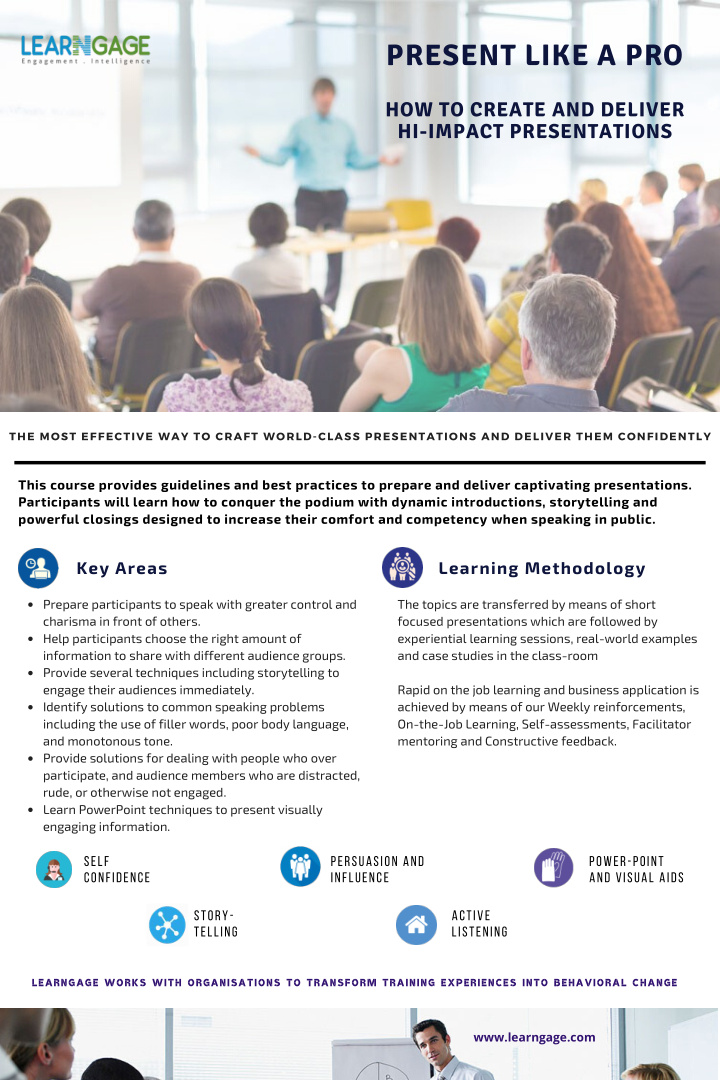



PRESENT LIKE A PRO HOW TO CREATE AND DELIVER HI-IMPACT PRESENTATIONS THE MOST EFFECTIVE WAY TO CRAFT WORLD - CLASS PRESENTATIONS AND DELIVER THEM CONFIDENTLY This course provides guidelines and best practices to prepare and deliver captivating presentations. Participants will learn how to conquer the podium with dynamic introductions, storytelling and powerful closings designed to increase their comfort and competency when speaking in public. Key Areas Learning Methodology Prepare participants to speak with greater control and The topics are transferred by means of short charisma in front of others. focused presentations which are followed by Help participants choose the right amount of experiential learning sessions, real-world examples information to share with different audience groups. and case studies in the class-room Provide several techniques including storytelling to engage their audiences immediately. Rapid on the job learning and business application is Identify solutions to common speaking problems achieved by means of our Weekly reinforcements, including the use of filler words, poor body language, On-the-Job Learning, Self-assessments, Facilitator and monotonous tone. mentoring and Constructive feedback. Provide solutions for dealing with people who over participate, and audience members who are distracted, rude, or otherwise not engaged. Learn PowerPoint techniques to present visually engaging information. Self Persuasion and Po w er - point Confidence Influence and visual aids Stor y- active telling Listening LEARNGAGE WORKS WITH ORGANISATIONS TO TRANSFORM TRAINING EXPERIENCES INTO BEHAVIORAL CHANGE www.learngage.com
PRESENT LIKE A PRO HOW TO CREATE AND DELIVER HI-IMPACT PRESENTATIONS COURSE OUTLINE The ABCs of Public Speaking: 1-Day 0 - 5 years Presentation Skills Basics Understanding How It Works: Communication To begin Participants will discuss the characteristics of strong speakers along with the mistakes to which novices often fall prey. Let’s Get Organized: Choosing a Structure If it’s not organized well, even important information will often be ignored or dismissed by an audience. During this part of the workshop, we will explore popular ways of organizing information and practice using various tools for structuring a presentation. Opening and Closing: Designing Strong Starts and Ends It’s often said that an audience will remember the first words a speaker utters and the last. Whether that’s true is debatable, but nevertheless, a strong opening and powerful close can set the tone for a talk and strengthen a presentation. This workshop component offers ideas for creating strong openings and closings. In this part of the course, participants will practice multiple options for introducing information and concluding remarks. Getting Ready to Jump: Positive Self-Talk and Confidence A big part of being great on stage is having a smooth start. During this part of the course, participants will learn how to build their self-confidence through preparation and positive self-talk. We will explore several tips and tricks for appearing comfortable and building rapport with an audience. Body Language Basics: Getting the Most from Yourself Great body language can support and enhance a message, while distracting body language can destroy it. This workshop component explores the value of planned body language and how to choose purposeful movements that will support specific points during a presentation. Curtains Up: Stepping on Stage This program concludes with a final practice exercise. Working in teams, participants will deliver a short presentation illustrating the points they learned during the course. Following the activity, the facilitator and class members will provide positive feedback and suggestions for improvement.
PRESENT LIKE A PRO HOW TO CREATE AND DELIVER HI-IMPACT PRESENTATIONS COURSE OUTLINE Hi-Impact Presentation Skills 1-Day / 2-Day 6- 20 years What It Looks Like: The Anatomy of a Successful Presentation This program begins with an examination of the parts of successful presentations: powerful introductions, effective transitions, and captivating conclusions. Participants will then dive in “head first” with a short practice presentation where they will be tasked to illustrate the principles discussed. Let Me Tell You: Understanding Audience Differences In the second segment of the program, participants will complete a self-assessment diagnostic tool, They will identify their communication style strengths and determine how they can leverage those strong points on stage. Following that exercise, they will consider other styles and actions they can take to accommodate audience members with different preferences. Story-Telling: Finding Key Messages and Organizing Information Our next activities focus on finding key messages and organizing information. Participants will work through a series of exercises designed to help them craft a strong narrative and support their assertions with robust examples, data, and other pertinent information. Flipcharts, PowerPoint, and Slides: Effective Visual Aids Choosing and using visual aids is an integral part of many presentations. This module reviews available options and covers the benefits and drawbacks of each. Highs and Lows: Adding Vocal Variety This part of the program focuses on building the participants’ confidence and helping them add visual and vocal variety to their presentations. To stretch their skills, we will consider a dozen ways to communicate the same message, and when it makes sense to use each. Stop Shaking in Your Shoes: How to Overcome the Fear of Public Speaking Fear is why many people do not enjoy public speaking. This workshop component examines the reasons for fear and techniques to overcome it. Participants will receive a checklist for projecting a professional image and learn how to eliminate such distracting speech habits as “um,” “ah,” and “you know. Tickling Their Funny Bone: How and When to Use Humor During this part of the course, we examine humor and its use on in a business presentation. We will discuss what’s appropriate, what isn’t, where to look for inspiration, and what to do if “funny” falls flat. Stand and Deliver: Preparation and Practice The program culminates with participants making various kinds of presentations: explanatory, informative, persuasive. Each participant will be videotaped for review and critique.
Recommend
More recommend